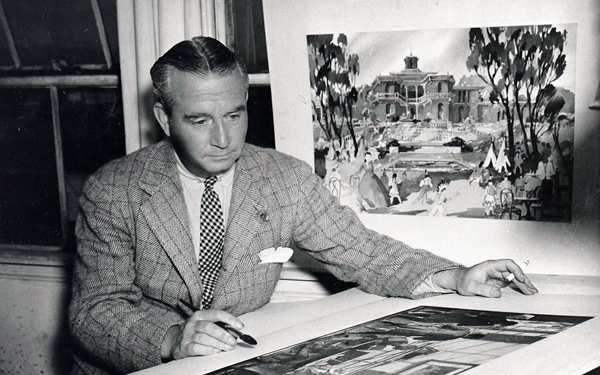By Tom Stempel.
William Cameron Menzies was one of the great production designers in the history of the movies. His credits include the 1924 Douglas Fairbanks Thief of Bagdad, Things to Come (1936), the 1940 Thief of Bagdad, and the film he is best known for, Gone With the Wind (1939). You may remember that I wrote a bit about his contributions to Kings Row (1942) in US #129. So why bring up Menzies now in an article for Creative Screenwriting?

William Cameron Menzies: The Shape of Films to Come, by James Curtis
James Curtis, whose great biography about Preston Sturges Between Flops I used a lot in my Sturges Project (reviewing the major Sturges films) in US #85-91 back in the House Next Door days of my column, has now written an equally good biography of Menzies, which is long overdue. Long, long overdue. It is called William Cameron Menzies: The Shape of Films to Come.
It got me to thinking about Menzies, and thanks to TCM and the UCLA Film Archives a number of Menzies films are available for viewing. So I want to get into in a little more depth than I did in the Kings Row piece the relationship between the production designer and the script.
Menzies created the role of production designer, which as he developed it, involved designing not only the entire look of the film (sets, locations, etc), but also sketching out what we now called storyboards, sketches of the camera angles. As I mentioned in US #129, Menzies did the sketches for Kings Row and passed them on to the cinematographer James Wong Howe.
The director, Sam Wood, had nothing to do with the visual look of the film; it was all Menzies and Howe. Before Menzies, the look of a film was a rather haphazard combination of whatever sets got built and how the cameraman decided to shoot them. Menzies’s work gave the films a visual unity, just as the screenwriter gives the film a temporal unity.

Ann Sheridan as Randy Monaghan and Ronald Reagan as Drake McHugh in Kings Row
One of his middle period silent films is The Bat (1926). It was based on a hugely successful play by Mary Roberts Rinehart and Avery Hopwood, with an adaptation by the film’s director and a continuity (shooting script) by Julien Josephson. The play is a semi-haunted house play and the makers tried, not very successfully, to open it up.
Menzies designed and storyboarded the opening scene of a jewel robbery that, while nice, has virtually nothing to do with the rest of the film. His primary designs are for the house and its various rooms. For all the style of his designs, the film is still very much a filmed play, with various characters talking in various rooms. West does not help in his direction, which may have stuck a little too closely to Menzies’s designs. Just when we want to get into the characters, West cuts to long shots to show off the set. West lets the designs overwhelm the film.
Menzies won the first Oscar for his designs for two films The Dove (1927) and Tempest (1928—the first Oscars were given for a two-year period). Tempest started out as a vehicle written by Mme. Fred de Gresac for John Barrymore. She was eventually replaced by Vladimir Nemirovich-Danchenko, and he was replaced by one of the great screenwriters of the silent era C. Gardner Sullivan.
You would think that the writer who created the “good bad man” that made William S. Hart the first great western star in the teens might not be the writer for a love story set in Russia leading up to World War I and the Revolution. Sullivan, however, wrote all kinds of scripts, from the 1932 film adaptation of Eugene O’Neill’s Strange Interlude to the 1934 adaptation of G.K. Chester’s Father Brown novels, Father Brown, Detective.
His script is infinitely more cinematic than the script for The Bat. Sgt. Markov falls in love with Princess Tamara in the days before the war begins, but when he is promoted to the officer ranks, he ruins his chances with her. He is thrown in prison and her fiancée makes sure he stays there while the other officers go off to war. The Revolution does not help matters.
Menzies designed a model of the village as well as the army barracks, the prison, and a ball room. The director here, a late addition to the production, was Sam Taylor, who uses Menzies’s designs well, but since his focus was on the actors, he also uses a lot of close-ups of Barrymore and the rest of the cast. Menzies’s designs support the film rather than overwhelm it.

Camilla Horn as Princess Tamara and John Barrymore as Sgt. Ivan Markov in Tempest (1928). Image © United Artists
H.G. Wells, the author of The Time Machine, wrote the script for Things to Come, based on his own novel. In Things, Wells imagines the coming World War II and the rebuilding of society afterwards. Raymond Massey, who plays the lead in the film, liked the novel.
Curtis quotes Massey as saying he was “fascinated by its humor and the earthy humanity of its characters…But when I saw Wells’ script I was appalled. Every trace of wit, humor, and emotion, everything which had made the novel so enthralling, had been cut and replaced with large gobs of socialist theory…” The producer Alexander Korda and Menzies, who was also directing, tried unsuccessfully to get Wells to revise it, but with no luck.

The Shape of Things to Come, by H.G. Wells
Menzies’s designs, especially for the post-war world, are stunning. His camera angles in the pre-war and war sequences are graphically dynamic. He has a montage of the lead-up to the war, in which his sense of dramatic visual composition is stunning, even if the montage runs longer than it should.
But then we begin to get the ponderously Wellsian speech-making, and the interest wanes until we get some striking action scenes. The visuals are much more compelling than the script, which is why the film as a whole does not work. There needs to be a greater coordination between the script and the production design as there was in Tempest.
Of course, it also does not help a modern audience to know that most of what Wells predicted did not come to pass. He assumed that air power would decide the war, which it did not. He assumed the war would drag on until the mid-sixties, which it did not. He assumed the British government would collapse, which it did not.
Menzies’s direction does not help. He did not like actors and had no idea how to talk to them. A more experienced director might have done more, but the inexperienced actors are blocks of wood, while the experienced ones like Cedric Hardwicke and Ralph Richardson give us great chunks of ham. Massey is relatively restrained until the end, when he lets go with Wells’ summing up.

Things to Come
In 1949 Menzies designed and produced a low-budget historical film noir The Black Book. Producer Walter Wanger had lost a bundle on his failed epic Joan of Arc (1948). Menzies figured he could redress some of the large sets from that film to fit a film about the French Revolution in spite of the three hundred years between the events in both films.
Philip Yordan eventually came up with a draft of the script that turned a lot of political speechmaking into a lively thriller. Robespierre has lost his little black book with the list of names of people he wants to kill and tries to get it back.
Menzies, in addition to using the standing sets for the bigger scenes, used minimal sets as he had on Kings Row, with his usual sketches for the cameraman and director. The match between the visual look and the script provides a claustrophobic feel that gives us the sense of the reign of terror closing in on everyone. Fortunately the cinematographer was the great film noir specialist John Alton, and the director was Anthony Mann, who has previously directed other low-budget films noir. Alton knew how to light Menzies’s camera set-ups, and Mann, a much better director than Menzies, got the best from his actors.

The Black Book, a.k.a. Reign of Terror
Menzies got another chance at director in 1951 with The Whip Hand. The original screenplay by George Bricker and Frank L. Moss dealt with a journalist who discovered Nazis in a compound in Wisconsin where they are hiding Adolph Hitler.
Again Menzies designed sets and shots, drawing five hundred sketches when the normal for a picture of this size would have been about two hundred. As in The Black Book, the feeling is very claustrophobic, which is fitting for the subject, as the journalist is trapped in the town near the compound.
Curtis quotes what director Lewis Milestone told Kevin Brownlow about art directors who wanted to direct, “The want a beautifully composed picture. They’re not interested in movement of tempo, just a beautiful picture. Well, that’s only good for the first scene. Pretty soon the actor’s got to move someplace, and there goes the composition.”
That’s true of Menzies as both art director and director. When you look at the films he made major contributions to the images are rather static. With a couple of notable exceptions (a tracking shot around the model of the village in the opening of Tempest, the camera pulling back on the wounded soldiers in Atlanta in Gone With the Wind and the opening moving camera in Kings Row), there are not a lot of moving camera shots in Menzies’s films. Watching Menzies’s films in the age of the relentlessly moving camera they seem old-fashioned.

The Whip Hand
There is almost no camera movement in The Whip Hand. The movement is in the script changes. Howard Hughes, the head of the studio, decided after filming was completed that Nazis were old hat, and the film rewritten and reshot to turn them into communists.
There is an opening scene now of a group of Soviet officers looking a map of the United States, and a changed headline of a story about an Nazi doctor announcing he had disappeared behind the Iron Curtain. And Hitler was cut out completely. I am not sure the new ending was any better or any worse than the original. It’s still an odd B movie. With a great look.
As a screenwriter you have to make sure you are telling the story as visually as you can, then hope you get a production designer who can make that as interesting as you hope it will be, and a director who knows how to deal with all that.

